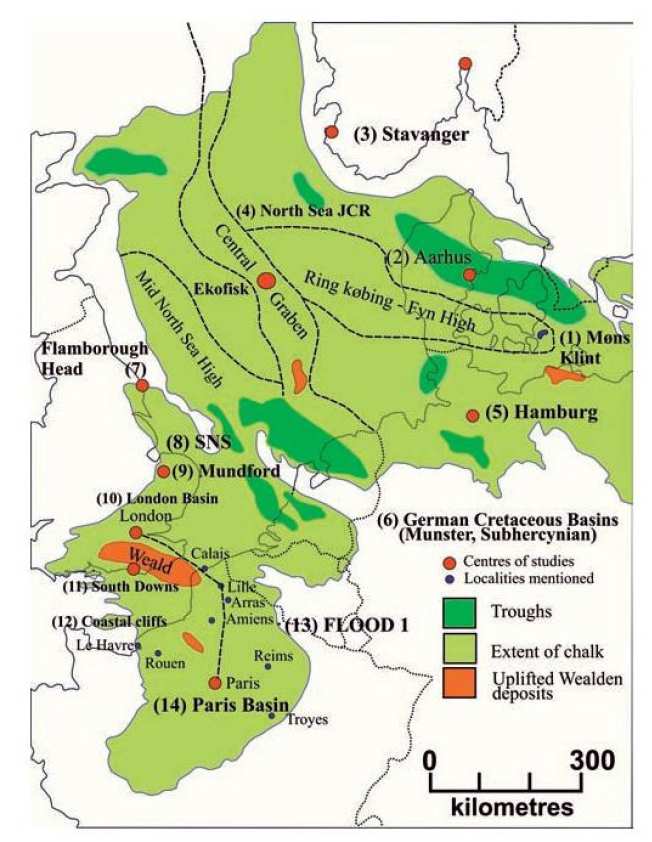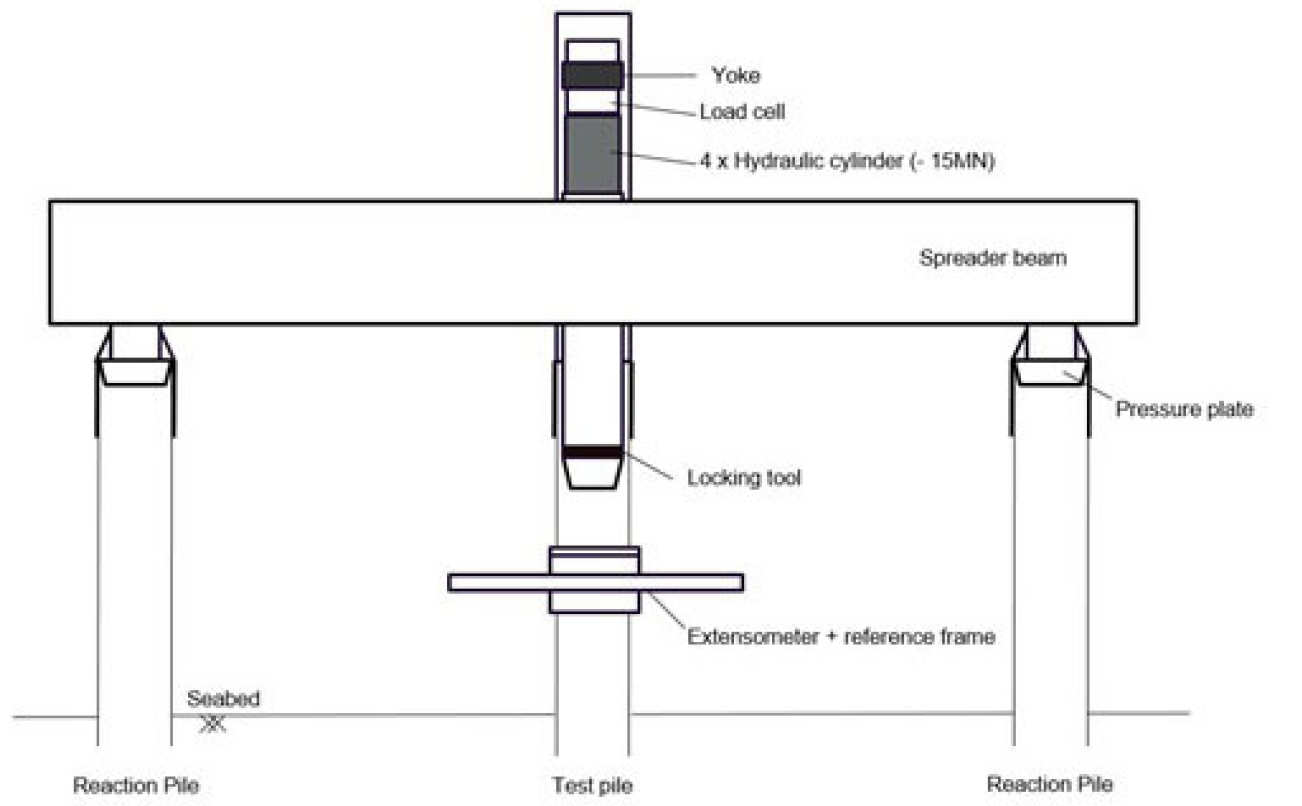Róisín Buckley
Rationalising offshore wind turbine pile design and assurance in difficult ground conditions
Started: October 2014
Supervisor: Jardine, R.J.; Kontoe, S.
Funding: Iberdrola/Innovate UK
Background
The current drive towards the development of renewable energy sources has led to increased expansion of offshore wind farms (OWF). Despite the high capital cost, the reliability of offshore pile design can be fairly low, particularly in certain ground conditions.

To date, the majority of OWF have been constructed in relatively shallow water (<35m) where gravity base and monopile foundations are suitable and lateral, moment and torsion loads dominate (Doherty et al., 2011). At greater depths, turbines are supported by jacket and tripod structures founded on open-ended driven piles where axial, compressive and tension loading are of concern.
OWF developments in Northern Europe encounter Chalk; a unique, highly variable and problematic soft rock. The Chalk of Europe (Figure 1) extends westward from Northern Denmark and Germany, to the British Isles (Bell et al., 1999). For driven piles, the CIRIA C574 (Lord et al., 2002) conservative limiting shaft resistances of between 20 and 120kPa for low to medium density and high density Chalk respectively, are primarily used by current designers.
It is well known that while driving resistance in Chalk is fairly low, set up effects are significant, as reported by Vijayvergiya et al. (1977). Previous research (Lehane, 1992, Chow, 1997) has confirmed the friction fatigue or “h/R” effect which may have a significant impact on the mobilised shaft resistance. It is also widely accepted that high compressive stresses occur beneath the pile tip, leading to de-structuration and chalk putty flowing along the shaft (Hobbs & Robins, 1976). A reduction in strength due to cyclic loading has also been demonstrated by Carrington et al. (2011) and Diambra et al. (2014).
In general, the behaviour of driven piles in Chalk is poorly understood and requires further research into, but not limited to: (i) friction fatigue; (ii) de-structuration during installation; (iii) set up; and (iv) the potential impact of cyclic loading applied to piles that have set up.
Description of Research
Iberdrola are currently developing the Wikinger OWF in the Baltic, offshore Germany. The project will consist of 70 wind turbine generators (WTG), installed in 35 to 42 m of water with an installed capacity of 350 MW. The WTGs are to be supported by 4 & 6 legged jacket structures on 2.67m diameter open-ended driven pipe piles. The piles will be founded in in about 50% Weichsellian Glacial Till & 50% Chalk of Maastrichtian age.
A full-scale pile test programme, completed in early 2015, employed original and innovative methods of static and cyclic pile testing as well as dynamic monitoring during driving. The specially designed test frame is shown on Figure 2. The results, along with the outcomes of related research projects and data collected from third parties, will be central to this research.

Research Aims
The research, funded by Innovate UK (formerly the Technology Strategy Board), is a joint industry project (JIP) between Iberdrola (the leader), Imperial College London (ICL) and the Geotechnical Consulting Group (GCG).
The research will have the following primary objectives:
- Assess the behaviour of the Glacial Till & Chalk with particular emphasis on the mechanisms at work in the Chalk;
- Review recent advances made and studies by other research teams in parallel research;
- Employ various available numerical methods to analyse the dynamic results and assess the behaviour during and at the end of driving (EOID);
- Analyse the results of the static and cyclic tension tests to assess the effects of loading, applied cyclic loading and set up in the Chalk and Glacial Till;
- Use the well characterised site to establish links between the results and the site investigation data and carry out further laboratory testing (including ring shear interface tests). Working within the framework for offshore pile design developed at ICL (Jardine et al., 2005) rationalise and improve current design methods.
References
- Bell, F., Culshaw, M. & Cripps, J. (1999) A review of selected engineering geological characteristics of English Chalk. Engineering Geology. 54 (3), 237-269.
- Carrington, T. M., Li, G. & Rattley, M. J. (2011) A new assessment of ultimate unit friction for driven piles in low to medium density chalk. Proc. 15th European Conference on Soil Mechanics & Geotechnical Engineering. , 825-830.
- Chow, F. C. (1997) Investigations into Displacement Pile Behaviour for Offshore Foundations. PhD. Imperial College London.
- Diambra, A., Ciavaglia, F., Dimelow, C., Carey, J. & Nash, D. (2014) Performance of cyclic cone penetration tests in chalk. Géotechnique Letters. 4 (July–September), 230-237.
- Doherty, P., Gavin, K. & Casey, B. (2011) The geotechnical challenges facing the offshore wind sector. Geo-Frontiers 2011: Advances in Geotechnical Engineering. , American Society of Civil Engineers. pp.162-171.
- Hobbs, N. & Robins, P. (1976) Compression & tension tests on driven piles in chalk. Géotechnique. 26 (1), 33-46.
- Jardine, R., Chow, F., Overy, R. & Standing, J. (2005) ICP design methods for driven piles in sands & clays. , Thomas Telford London.
- Lehane, B. (1992) Experimental Investigations of Pile Behaviour using Instrumented Field Piles. PhD. Imperial College London.
- Lord, J. A., Clayton, C. R. l. & Mortimore, R. N. (2002) Engineering in chalk. 1st edition. London, UK, CIRIA.
- Vijayvergiya, V., Cheng, A. & Kolk, H. (1977) Design & installation of piles in chalk. Offshore Technology Conference. , Offshore Technology Conference.
RÓISÍN BUCKLEY
 PhD Candidate - Geotechnics
PhD Candidate - Geotechnics
Department of Civil & Environmental Engineering
Imperial College London SW7 2AZ
roisin.buckley13@imperial.ac.uk


